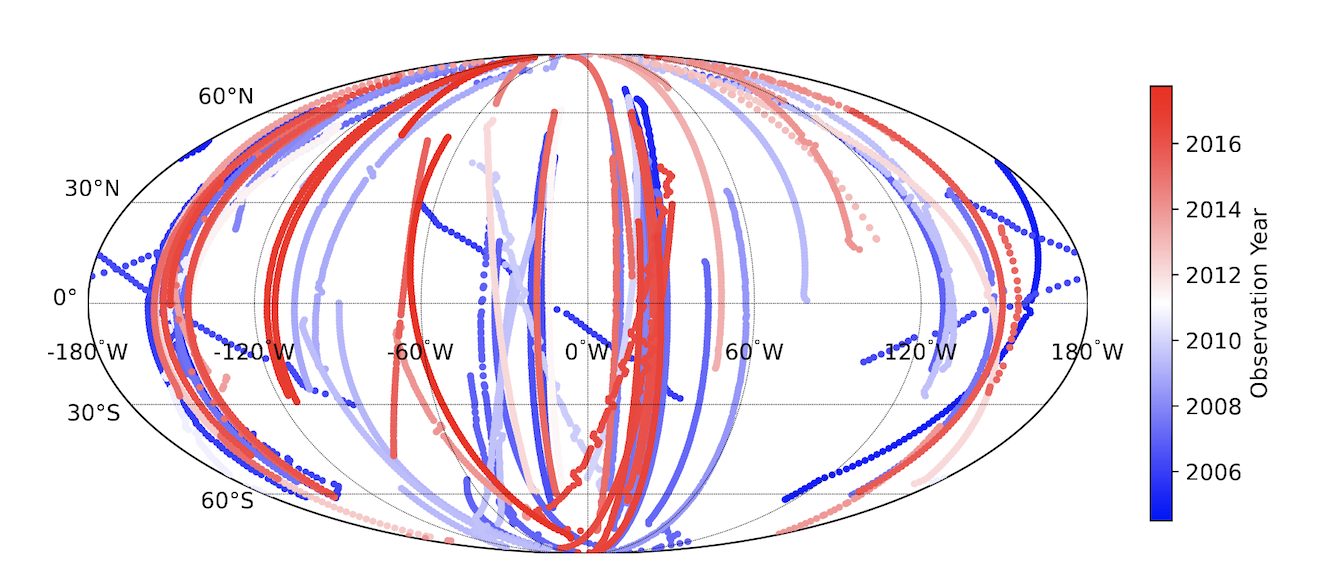Seasonal variation of Titan’s stratospheric tilt
- 1School of Earth Sciences, University of Bristol, Bristol, UK (lucy.wright@bristol.ac.uk)
- 2Atmospheric, Oceanic, and Planetary Physics, University of Oxford, UK
- 3Planetary Systems Laboratory, NASA Goddard Space Flight Centre, Greenbelt, USA
Titan’s entire stratosphere is in superrotation and rotates about an axis offset by approximately 4o from its solid-body rotation axis [1]. However, the mechanism causing this offset is not yet understood. The tilted axis has been determined previously through temperature retrievals [1, 2], composition retrievals [3, 4], and by analysis of images of stratospheric haze [5, 6, 7] and polar clouds [8]. We independently determine the magnitude and direction of the stratospheric tilt from temperature and composition maps at a higher spatial resolution compared to previous studies. This is achieved by inverting mid-infrared spectra (580—1500 cm-1) acquired by Cassini’s Composite Infrared Spectrometer (CIRS) [9-11] and using the NEMESIS [12] radiative transfer and retrieval tool.
We use observations acquired at low-spectral resolution (SR, FWHM ~ 14.5 cm-1) with nadir viewing geometry. These observations offer excellent spatial and temporal coverage throughout the Cassini mission (Figure 1) and typically have the best horizontal spatial resolution and lowest noise per spectrum of any of the CIRS observations. While spectral features in these data are often blended and subtle, previous studies have demonstrated accurate modelling using NEMESIS [12] with a correlated-k forward model [13].
In addition to determining an average stratospheric tilt, we investigate the seasonal evolution of the tilted axis over almost half a Titan year (2004—2017). This takes advantage of the excellent temporal coverage of the underused CIRS low-SR dataset. The seasonal evolution of the tilt is not well known and has only been determined for the full Cassini mission through Titan’s stratospheric haze annuli [14]. However, these annuli are observed at higher altitudes than the region probed by our retrievals, which are sensitive to approximately 1 mbar. Moreover, the haze annuli can become unclear around 2012—2015 as Titan’s mean meridional overturning circulation reverses. Our study should provide a more reliable estimate for the tilt during this period, and a powerful independent comparison to [14] over the full Cassini mission. Quantifying Titan’s stratospheric tilt axis, and its potential seasonal evolution, yields valuable insight into the dynamics responsible for the offset and the mechanisms that drive superrotating atmospheres in general.

Figure 1 Mission coverage of the observations used. We use low-spectral resolution nadir spectra acquired by Cassini’s CIRS instrument. The acquisition date of each observation sequence is indicated by colour.
References: [1] Achterberg et al., 2008b [2] Achterberg et al., 2011 [3] Teanby et al., 2010 [4] Sharkey et al., 2020 [5] Roman et al., 2009 [6] Kutsop et al., 2022 [7] Vashist et al., 2023 [8] West et al., 2016 [9] Flasar et al., 2004 [10] Jennings et al., 2017, [11] Nixon et al., 2019 [12] Irwin et al., 2008 [13] Wright et al., 2024 [14] Kutsop et al., 2022.
How to cite: Wright, L., Teanby, N. A., Irwin, P. G. J., Nixon, C. A., and Ford, J. S.: Seasonal variation of Titan’s stratospheric tilt, Europlanet Science Congress 2024, Berlin, Germany, 8–13 Sep 2024, EPSC2024-428, https://doi.org/10.5194/epsc2024-428, 2024.